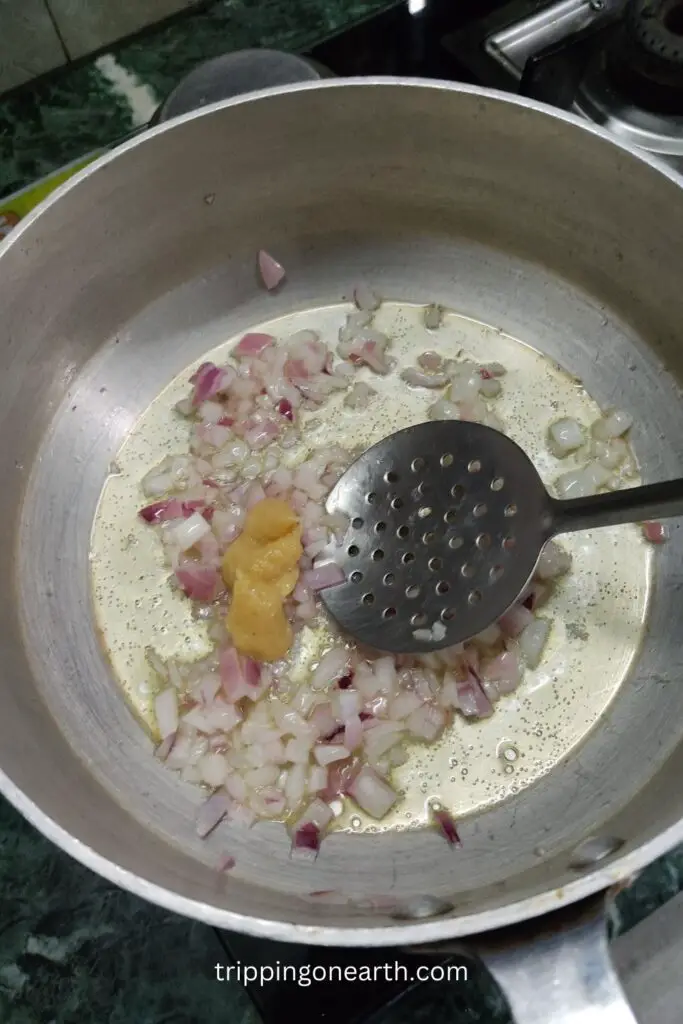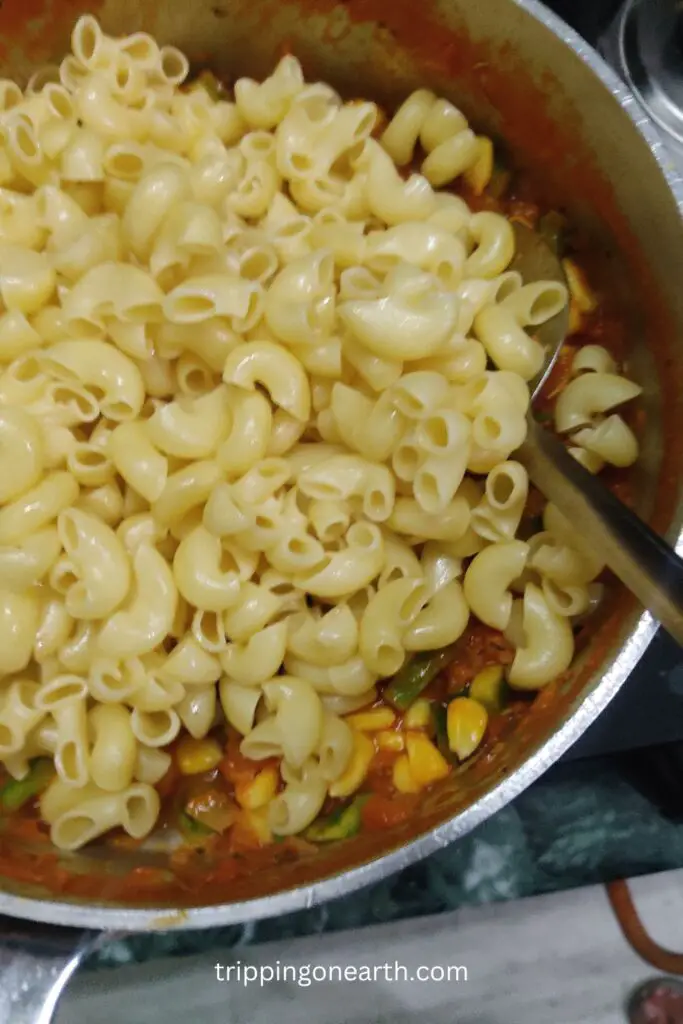This post may include affiliate links. Read the disclosure policy here. Thanks for the support!
The richness of tomato sauce and the richness of cream are combined to create the tantalizing pink sauce pasta, sometimes referred to as rosé sauce pasta. Pasta lovers’ taste senses have been captivated by this exquisite blend of flavors and colors that has gained appeal across the world. The dish’s pink color lends a touch of elegance, while the creamy and acidic flavors strike a pleasing balance.

I particularly make this dish when I’m craving pasta and also want to freshen things up!
I mean how many times can you make red sauce pasta or white sauce pasta?
So making this recipe for pink sauce pasta gets me the best of both ‘worlds’ or should I say the best of both ‘pastas’.
PS: Sorry for the blurry images. I was having some issues adjusting the camera.
About The Dish
Pink sauce pasta’s introduction as a spinoff of traditional tomato- and cream-based pasta sauces can be credited to Italy. In the 1980s, this scrumptious fusion became a well-liked meal, and it has since changed and evolved with regional variations throughout the world.
Its popularity was further boosted by the surge in foreign travel and intercultural culinary interactions, which led to its ubiquity in Italian-American cooking. Pink sauce pasta is still served today and can be seen on the menus of many Italian eateries. It has evolved into a cherished handmade comfort dish that people appreciate for its delicious flavors and adaptability.
Here’s how to make pink sauce pasta recipe!
Utensils You’ll Need
- Deep Frying Pan: To cook the pasta.
- Strainer: To strain the pasta after boiling it in water.
- Big Tablespoon/Ladle: To saute and stir.
- Grinding Jar: To make tomato puree.
Ingredients Poured
Pasta: Pick the pasta you like most, such as spaghetti, rigatoni, penne, or fettuccine. I chose to make it with macaroni pasta but it’s up to your liking.
Onions & Tomatoes: Tomato sauce and cream are what gives the color to the pink sauce for pasta. As a basis for the sauce, you can use canned crushed tomatoes or tomato puree. White or yellow chopped onions are frequently sautéed with garlic to create a flavorful sauce base.
Veggies: Vegetables like green, red, or yellow bell peppers and corn give the pasta more nutritional content as well as it gives a crunch to each bite.
Cream: The pink sauce for pasta has cream or milk added to give it a creamy texture. A rich texture and flavor are frequently achieved by using heavy cream or half-and-half. However, you may use healthier substitutes like whole milk or light cream. But I’m not using milk in this recipe pink sauce pasta.
Cheese: Cheese helps to enhance the flavor of the pink sauce for pasta. The most common cheese used in this pasta is parmesan but you can also go for mozzarella like I did.
Ginger-Garlic Paste: The flavors of ginger and garlic give the sauce depth and flavor. I used ginger-garlic paste since it was convenient, but if you like a stronger garlic flavor, mince the garlic cloves finely for a more pronounced flavor.
Herbs and Spices: Pink sauce pasta has various herbs and spices added to it to make it taste better. Basil, either fresh or dried, oregano, parsley, red pepper flakes, and powder for a hint of spiciness, and black pepper for flavor are typical additions. If it’s accessible to you, use basil; I personally did not.
Salt to Taste
Oil & Butter
How to Make Pink Sauce Pasta
For boiling pasta:
1. In a heavy bottom pan, bring water to a boil, add the salt and oil, and then add the pasta and cook until al dente.

2. Drain the pasta and place it in a bowl. To prevent sticking, add extra oil.
For pink sauce pasta:
3. Add onions to a skillet with hot butter and sauté until they are translucent. then thoroughly combine ginger-garlic paste and red chili powder.




4. Add salt and tomato puree, stir well, and simmer over high heat for 5-7 minutes.


5. Add ketchup, sweet corn, bell peppers, oregano, and chilli flakes. Stir in the cooked pasta, and mix thoroughly.




6. Stir in the fresh cream, then boil for one minute.


7. Add processed cheese and coriander leaves as garnish.

8. Your pink sauce pasta is ready.

Tips & Tricks
The meal is made more exciting and visually appealing by experimenting with various pasta shapes, from penne to fettuccine, which also enables each cook to modify the recipe to their own.
Vegetarians can enjoy a meatless version by adding sautéed mushrooms, bell peppers, or spinach. For those seeking a heartier option, grilled chicken, shrimp, or Italian sausage can be incorporated.
You can also combine the white sauce and the red sauce to make this dish.
How to Serve
Pink sauce pasta is a hearty meal that works well as both a main course and a side dish. For a well-rounded supper, serve it with garlic bread or a fresh green salad.
To enhance the acidic tomato flavors and creamy richness of this delicious pasta, serve it with a light-bodied red wine, like Pinot Noir or Chianti.
A delicious iced tea or sparkling water with a touch of citrus works wonders for a revitalizing non-alcoholic choice. For an authentic Italian dining experience, end the dinner with a decadent dessert like tiramisu or panna cotta.
Nutrition
Pink sauce pasta has certain nutritional benefits, but it’s vital to keep in mind that the precise makeup and serving sizes might change based on the recipe and the tastes of the consumer. We can, however, give a broad summary of the potential nutritional benefits of pasta with pink sauce.
- Calories: Pink sauce pasta’s calorie count will vary depending on the precise components and serving size. A 1-cup dish of cooked pasta with pink sauce typically has between 250 and 350 calories. Nevertheless, depending on the modifications and component amounts used in the recipe, this might change greatly.
- Carbohydrates: The pasta itself is the primary source of carbs in pink sauce pasta. The type of pasta used will impact the amount of fiber and total nutritional value, whether made from whole wheat flour or refined flour. A typical portion of cooked pasta is 40–45 grams of carbs in 1 cup.
- Protein: Pink sauce pasta’s protein may come from various ingredients, including meat, fish, and vegetarian choices such as mushrooms or tofu. Additionally, cheese increases the protein value if used as a garnish or as part of the sauce. Usually, cooked pasta has 8 grams of protein per 1-cup portion.
- Fats: The cream, olive oil, or cheese used to make the sauce are the main sources of fat in the pink sauce pasta. While olive oil offers monounsaturated fats, which are seen as better alternatives, cream may be a substantial source of saturated fats. When taken in moderation, cheese can also increase the total fat content. To maintain a healthy consumption of fat, it’s crucial to balance the amounts of these components.
- Vitamins and Minerals: In pink sauce pasta, vitamins and minerals may be present depending on the components. For instance, tomatoes are an excellent lycopene, potassium, and vitamin C source. In addition to adding flavor, onions, and garlic contain trace amounts of vitamins and minerals. Furthermore, if vegetables or herbs are used, they can improve the dish’s overall nutritious profile.
It’s important to note that pink sauce pasta’s nutritional profile can be changed to accommodate different dietary choices and health objectives. The nutritional content of the recipe can be improved by adding whole-wheat pasta, lean protein sources, and more veggies. In addition, moderation and quantity management are essential for maintaining a healthy and balanced diet.
How to Store
Refrigeration: Let leftover pink sauce pasta come to room temperature before storing it in the fridge. Pasta should be transferred to an airtight container or placed in a plastic bag that can be sealed. To keep things fresh, make sure to eliminate as much air as you can. For up to three to four days, keep it in the refrigerator.
Freezer: Pasta with pink sauce can be frozen for longer-term preservation. Transfer the pasta to a freezer-safe container or freezer bag after it has cooled. Once more, eliminate extra air to avoid freezer burn. Put the container in the freezer after marking it with the date. Pasta with pink sauce may be frozen for 1-2 months.
Separate the pasta and sauce: It is better to store the pasta and sauce separately if you plan to keep red sauce pasta for a long time. This will stop the sauce from being watery and the pasta from getting soggy. When you’re ready to serve, combine the pasta and sauce and store them separately in two containers.
Why I Love Pink Sauce Pasta
- It is a very versatile dish that you can customize according to your liking.
- Veggies like bell peppers and corn gives the pasta a nutritional boost.
- The ingredients are easily available and accessible.
More Pasta Recipes That You’ll Love
Please rate and comment if you make this pink sauce pasta so I know how much you like it.

Pink Sauce Pasta (Without Maida and Milk)
Equipment
- Deep frying pan
- Tablespoon/Ladle
- Grinding jar
Instructions
- In a heavy bottom pan, bring water to a boil, add the salt and oil, and then add the pasta and cook until al dente.
- Drain the pasta and place it in a bowl. To prevent sticking, add extra oil.
- Add onions to a skillet with hot butter and sauté until they are translucent. then thoroughly combine ginger-garlic paste and red chili powder.
- Add salt and tomato puree, stir well, and simmer over high heat for 5-7 minutes.
- Add ketchup, sweet corn, bell peppers, oregano, and chilli flakes. Stir in the cooked pasta, and mix thoroughly.
- Stir in the fresh cream, then boil for one minute.
- Add processed cheese and coriander leaves as garnish.
- Your pink sauce pasta is ready.
Notes
- The meal is made more exciting and visually appealing by experimenting with various pasta shapes, from penne to fettuccine, which also enables each cook to modify the recipe to their own.
- Vegetarians can enjoy a meatless version by adding sautéed mushrooms, bell peppers, or spinach. For those seeking a heartier option, grilled chicken, shrimp, or Italian sausage can be incorporated.
- You can also combine the white sauce and the red sauce to make this dish.
